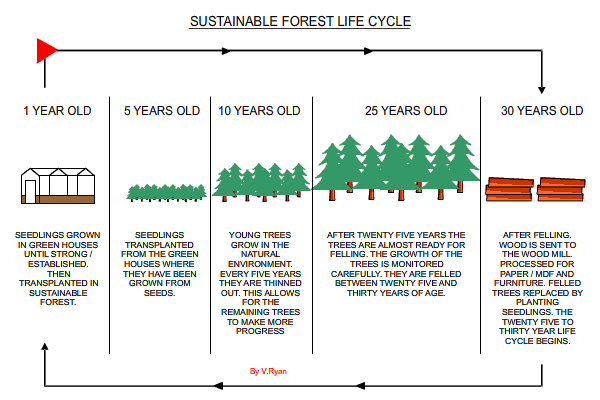The quality of our forest systems is connected to the status and development of economic systems, cultural identities, and a measurement of the influence we have on the planet: past, present, and future. Management of the resources used from forest systems is necessary as the value we place on these resources influences their extraction. Extraction methods, such as those found in Addictive Economies and Coal Dependency and in the below video Leveling Appalachia(full documentary redirected to other site) are consequential not only to the previously mentioned quality of our forest systems but to the social organizations that practice them as well.
Video by: e360.yale.edu
What is Forestry?
“Forestry is the science and craft of creating, managing, using, conserving, and repairing forests and associated resources to meet desired goals, needs, and values for human benefit.”
Video by: Forest Fact Break
Why manage?
The complex systems described in the above video on Oregon’s forests show the separate areas of human activity that culminate in forests such as logging, recreation, or the preservation of important aspects of the ecosystem that allow the forest to continue its natural functions. The forest is a resource, it provides the supplies that we as societies use to develop which means it must be managed as long as it is in danger of over exploitation.
Over exploration of this resource would have dramatic effects on the systems of our planet and in turn our ability to continue the development of our societies. Below is a time-lapse video from 1999 to 2012 provided by Landsat Satellite Imagery that shows the deforestation of Amazonian forests in order to create farm and cattle lands.
Video by: Land Satellite Imagery
The changes that take place in locations such as this are staggeringly fast but the regeneration of a forest ecosystem to where it was before human involvement can take hundreds or even thousands of years in some cases. While it is conceivable to grow tree populations back we currently lack the ability to influence the complex development of an old growth forest. Such research on forest regeneration is being preformed at the Federal University Of Paraná.
How do we manage?
Management of forest systems, and resources in general, is dependent on many variables. There is the geographic location and type of forest, which can be found on the Through The Woods page. The socioeconomic atmosphere of the country or countries in which the forest exists. The purpose of the forest, the condition of the forest, who is managing the forest: local, state, national, transnational, no one. All of these and other conditions play integral roles in the success of a management program.
With such a wide range of influential conditions there exists a variety of methods and policies used in the management of forests and extraction or resources, such as:
Sustainable forestry – “A sustainable forest is a forest that is carefully managed so that as trees are felled they are replaced with seedlings that eventually grow into mature trees.”
GIF by: technologystudent.com
Silviculture – “the practice of controlling the establishment, growth, composition, health, and quality of forests to meet diverse needs and values.”
Shelterwood cut – “Harvest both small and some large trees leaving larger trees to act as seed trees; favors trees that require less than full sun light. Reevaluation and second cut practices.”
Improvement thinning – “Designed by a professional forester to provide income, habitat, and protect all other resources by reducing to 60 percent according to size, species, and spacing.”
Seedtree – “Similar to a shelterwood cut but leaves fewer trees and depends on the trees to reestablish themselves by seed dispersal.”
These are just a few examples of alternatives to unmanaged practices that aim to extract the natural resources of the forest without the institution of consequential analysis. There are theories that show distrust of governmental management systems such as those found in The Benefit of the Commons or in Neoliberal Conservation methods as such government institutions have failed in the past to produce results. The issue that I have found however is not that it is the presences of government control but the lack of control from the citizens that utilize these resources. In fact, there has been definite results found in the implication of policies aimed at reducing deforestation yet only in the presence of a monitoring system that ensures such policies are maintained. This is potentially the first step to renovating the relationship between the economic, ecological, political, and social realms of the world; an analysis best suited for Political Ecology.
